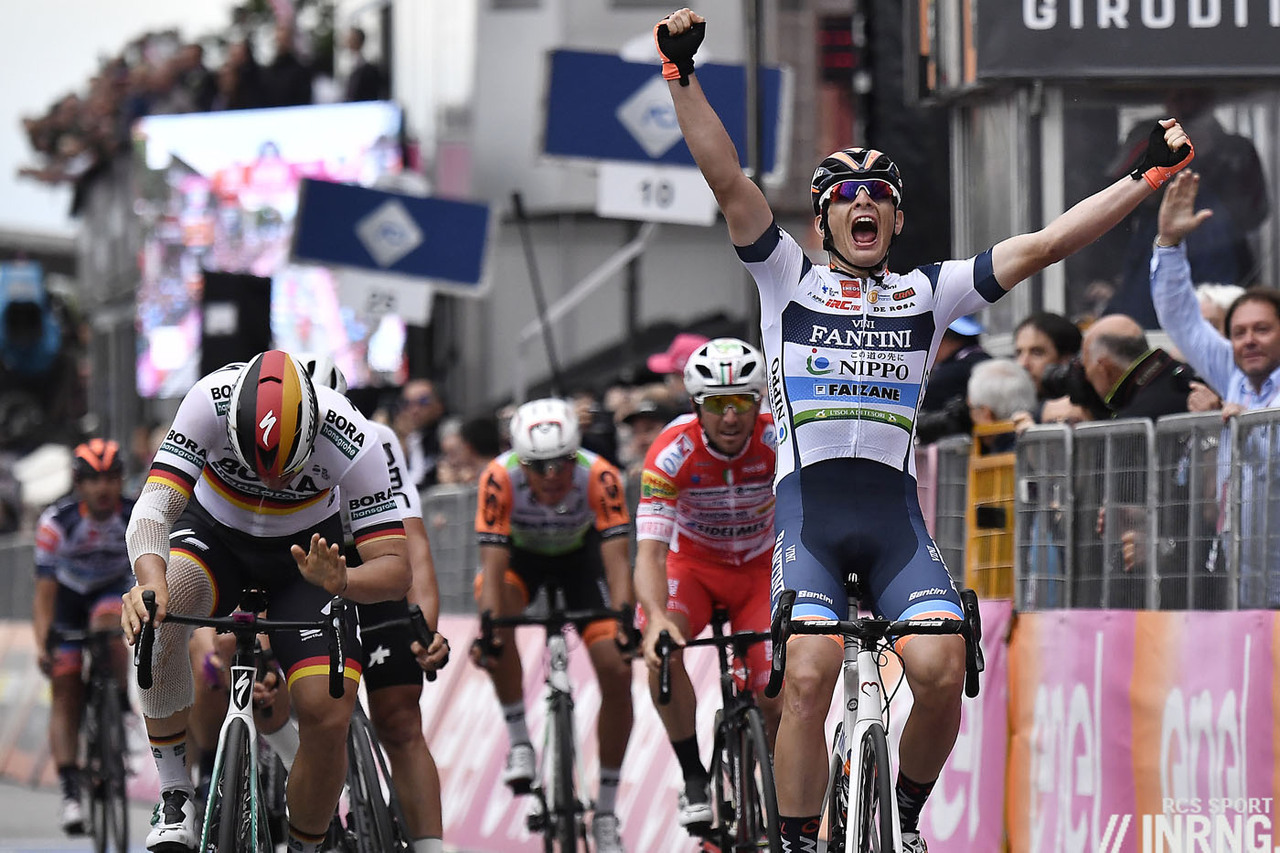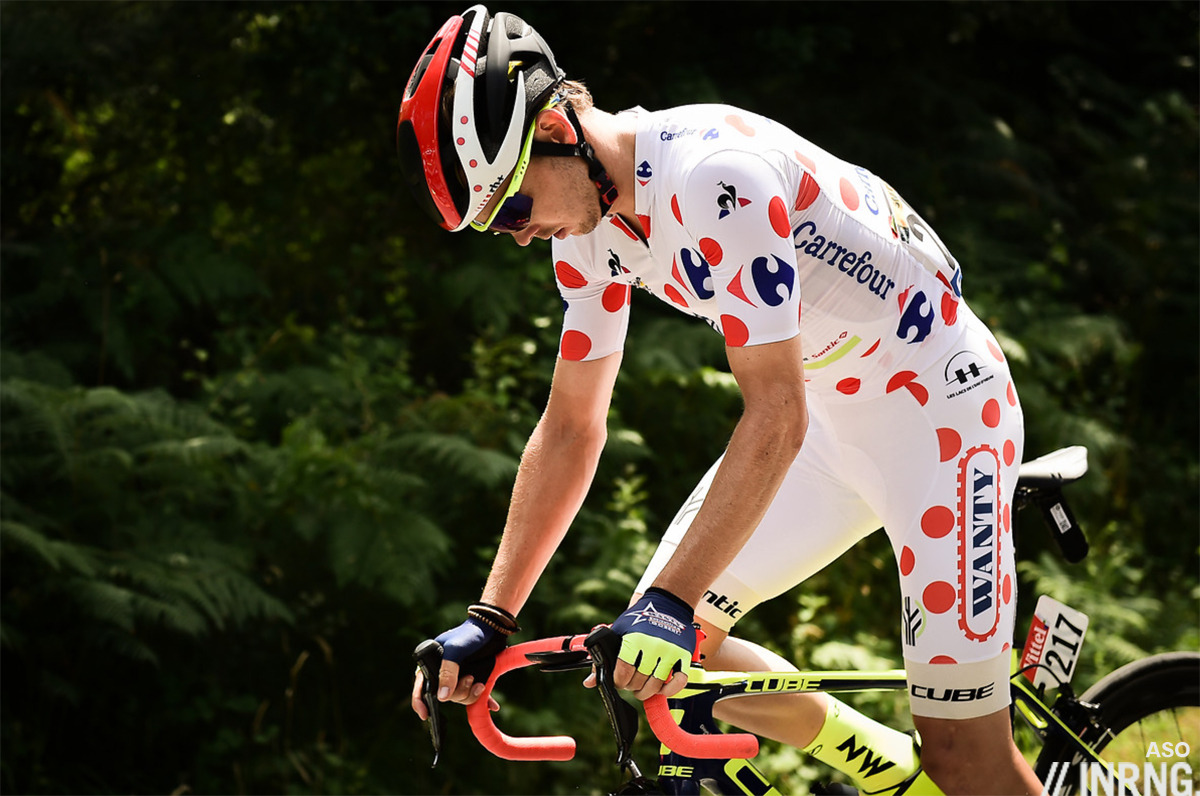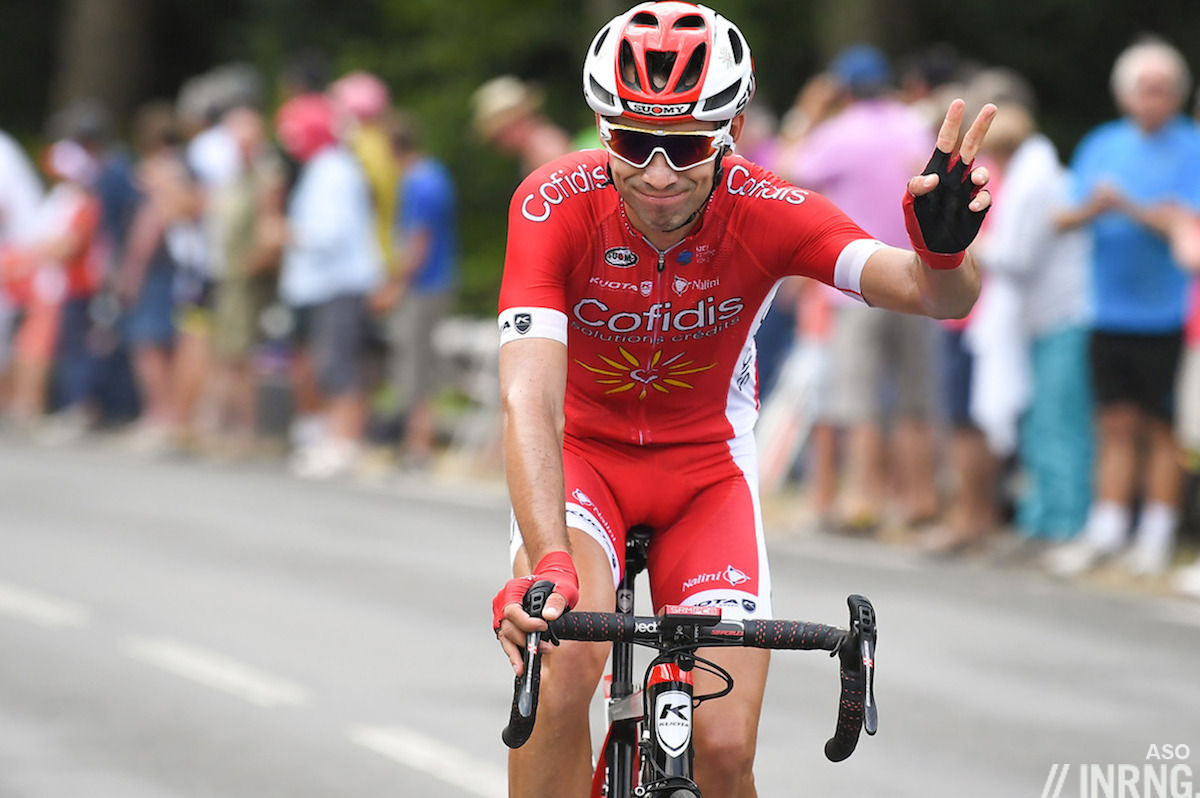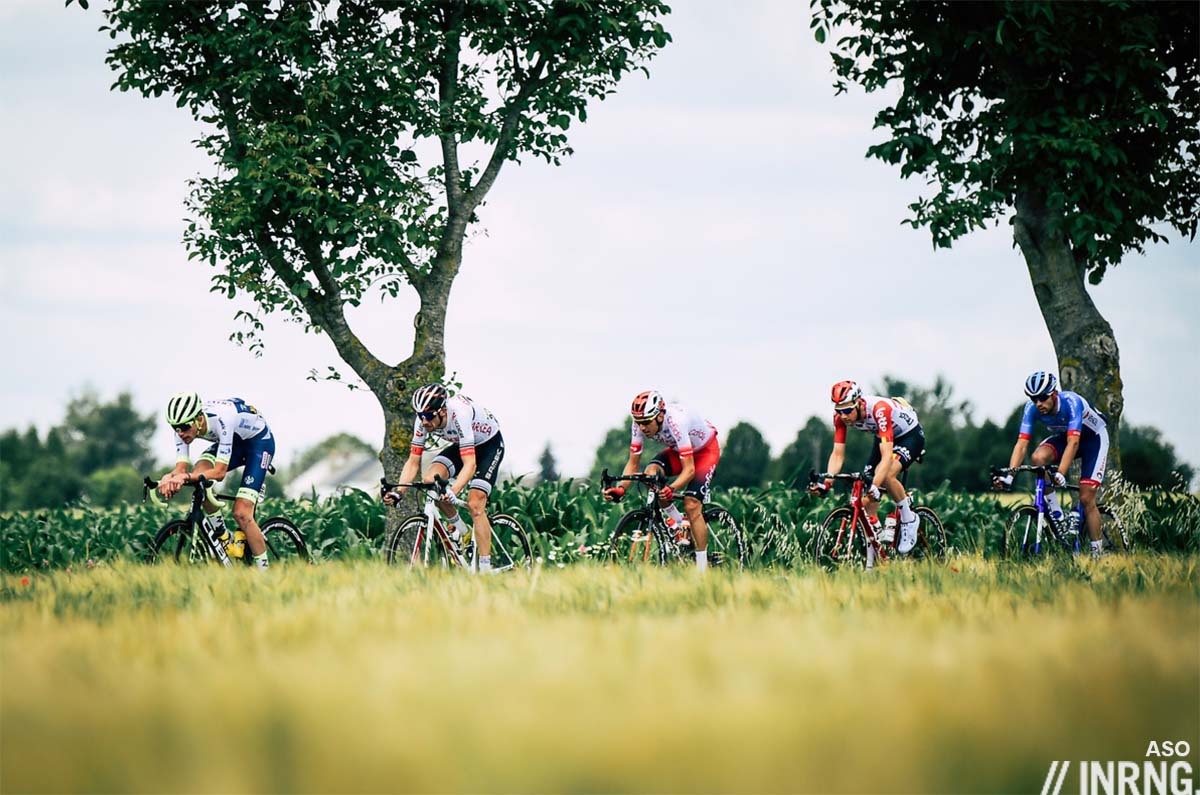The riders pass the Kilomètre 0 point, Christian Prudhomme waves his flag and the race gets underway. Instantly a handful of riders from the wildcard teams stand on the pedals and go clear. Only this kind of move doesn’t work so why waste the energy? They say it’s to “show the jersey” but is this a good image? Maybe it’s just great fun.

The breakaway can have its day even when it looks like a nailed-on sprint finish. See Dario Cima in the Giro this year – that’s him in the picture and he hasn’t won the sprint, he has just managed to stay clear all day – or Jelle Wallays in the Vuelta last year. But the Tour? We have to go back to 2010 when Sylvain Chavanel won the stage to Spa, it was promised to the sprinters but it poured, the roads were slippery, the peloton staged a mini protest which let Chavanel stay away, freak circumstances. So we go back to 2009 and Thomas Voeckler’s stage win in Perpignan for a day that should have been a sprint but wasn’t. It’s testimony to how controlled the Tour de France is, days that look like bunch sprints end in bunch sprints and teams bring their best riders, for example Tony Martin was deployed by Jumbo-Visma yesterday to contain the breakaway. It creates a Catch-22 scenario as since it hasn’t happened this decade, few want to try and stay away on a flat day so few will try and the only ones to have a go are, say, four riders from wildcard teams and they simply don’t have the horsepower to stay away.

So why try? First there can be a good reason if there’s a tactical objective such as a couple of fourth category climbs because this brings the mountains jersey early in the race. This time last year Dion Smith went in the breakaway on the first day and yes they got caught before the finish but not before the New Zealander collected the mountains jersey, earning a podium appearance and media attention that his modest Wanty-Gobert team craves. Even just collecting a few points at the intermediate sprint means a bit of prize money for the team. Hope dies last and there’s always a chance the move sticks.
It’s often said getting the team jersey on TV matters. Now winning against the odds is an attractive proposition but by extension those odds mean the logo is more often associated with doomed efforts and failure, is this really the kind of effort the brand wants? The Pro Conti teams have budgets ranging from €2 million to €10 million and frankly this would buy a lot of TV ads but cycling can reach parts of France other marketing campaigns cannot. Also maybe that day the team has invited VIPs such as top clients or star salespeople and they need to see something happening.
Another reason is self-fulfilling, the teams are invited to the race in order to go in these breakaways and so now they’ve been invited they must go in the breakaways otherwise if they don’t then they might not be invited back. Wildcard teams are expected to “animate” the race, pro cycling’s euphemism for supplying cannon fodder. A breakaway, even a doomed one, provides us with a race rather than a procession and helps rotate the TV images and gives commentators more to talk about, like the time gaps and analysis of which team is chasing. This matters to the race and the all important TV production.
Finally there’s another good reason to go up the road: the joy of it all. The Tour de France is a street party and you enjoy the applause of the public, something special for any local riders on the day. Nevermind getting the jersey on TV, how about putting yourself in the picture instead.

Conclusion
These early breakaways are doomed in the Tour de France, if they succeed in the Giro and Vuelta every now and then they seem near impossible in the Tour de France. This becomes self-perpetuating as no big rouleurs are going to spend energy on it. It’s said it matters because lesser teams can “show the jersey” but is trying and losing a good image for a brand? It probably depends. Some teams are invited to the race on the implicit assumption they’ll animate the race, they ensure a race rather than a procession and if it’s doomed and of questionable value, there’s always the thrill of the chase and the cheers of the crowd. Not everyone can win but trying is part of the fun.


Fun to imagine Thomas Voeckler teaching the French national team how to do it…
You mention Tony Martin inrng in a different context, but what about his breakaway then solo effort in the 2014 TDF?
With, if I remember correctly, Julian Alaphilippe.
That one was in 2016.
wasnt that the Vuelta?
No.
http://inrng.com/2013/08/vuelta-stage-7-preview/
was the one I was thinking about….
a 1/2 for Viviani’s lead out men. I miss Lampre’s kit!
Apologies, that was 2016.
Alaphilippe clearly made a good recon of this stage. The way he was descending down that last descent, with his hand on the top of the handlebar, breaks out of reach and through corners with no visibility was amazing to see. And his explosiveness always strikes me. It seems so easy when he does it. Only his facial expressions tell us the real story. What a guy!
You question whether ‘trying but failing’ is good for a brand’s image.
The alternative is not trying at all, just riding round in the pack, invisible – what good is that, you’ll have spent your sponsorship euros on what exactly ?
Doubtless you’ll have marketing on your company website saying you have riders in the race, maybe cardboard cut-outs of the riders in your bank branch/supermarket/DIY store entrance – but anyone watching on TV won’t see them, it’ll just be pointless. On the other hand, if they’re in the lead group and getting TV footage, viewers tuning-in will see them and you’ll get your brand exposure.
If you’ve invited VIPs to the stage, you’ll maybe have had some of your riders drop in at the start and now they don’t just know your company but they also know the riders as people and will feel involved with them when they see those riders out at the front, they’ll probably know that the break is doomed but they’ll be willing those riders on to stay clear or hold off the pack as long as possible.
I think you’re right but it varies. Wanty can look valiant trying, Cofidis with their roster and budget less so?
Cofidis manage to contest more stages on merit than Wanty (Laporte in the top 10 on stage 4) so they have less of an obligation to go for TV time.
Fun. It’s so nice to see that word in a sport that has become so calculated and scientific. It’s the reason why we all started riding. Pure joy. Great commercial break.
The only thing I don’t get is why was this stage yesterday so clearly assigned for the sprinters? Or even a bunch sprint? That last climb was actually very tough given the circumstances and the previous one was not an easy one either.
Think you mean to comment on the day’s stage preview. But yesterday was no sprint stage, hope nobody called it for them?
Indeed. Excuses, got confused.
I suppose its better than just sitting and watching for so long before getting dropped. I wonder how much of it is contractual though, like they are told if they get the invite they have to go in the break? Because surely a lot of the time they’d be more effective at launching an attack in the last 10-5k? Especially Total Direct Energie with Terpstra.
I doubt it’s contractual. But the team have no doubt made promises and lobbied to be in the Tour, so that had better live up to their billing or else another team gets invited.
By giving a team an invite they need to give the Tour something back, whether that is global exposure (7Up) or French pride (Europcar).
But that’s another thing that has changed: in the past you had a lot of attacks in the final kms, with specialists like Jelle Nijdam and Vladislav Ekimov. Terpstra seems to be the last of the Mohicans when it comes to that specialty and even he doesn’t try it that often anymore.
the only thing that matters is getting an invite.
An invite means they can get $ from a sponsor and still exist next year. Take cofidis and direct energy.
They only have large budgets because they go to the tour every year. No tour no high budget team.
So if getting in the breakaways is what is important to stay in the tour then they have to do it.
Realistically if they have a rider good enough for a high GC or stage finish they don’t need much support other than getting drinks. They don’t need to save riders for pace setting or chasing down the break away as they don’t have the riders for it anyway.
“These early breakaways are doomed in the Tour de France, if they succeed in the Giro and Vuelta every now and then they seem near impossible in the Tour de France.” is exactly what makes Le Grand Boucle so often unsatisfying for old-farts like me. Plenty of ways this might be fixed (which I’ll save you from here) but I guess a lot of folks must like the situation?
OTOH- Chapeau to Alaphillippe and ASO for yesterday’s stage!!!
Followers of the Lanterne Rouge have long joked about another reason to get in the break. Get out front, call a truce with your pursuers and take it easy knowing that nobody particularly wants to catch you because it’ll only start the whole process of forming a break off again, get caught with 30km to go and then slide straight out the back to take lots of lovely time without your DS being able to complain because, after all, you’ve been ‘working’ all day.
Not entirely convinced this doesn’t happen, either…
A variation on that scenario is to get into the break on the day before the race goes into the mountains, so you can get out of being asked to do anything the next day.
Sounds logical, but contains a trap – the mountains are the worst place for Lanterne Rouge candidates to take time because the autobus tends to roll in fairly close to the cut off, so the amount of time you can take is limited. Doing it before one of the intermediate stages with a few hills but nothing treacherous would work though – it’s a bit obvious if you soft pedal on a dead flat stage.
And yes, I have spent way too much time thinking about this!
Is it just me or has the way the break forms changed over the last few years? I’m sure I used to read about several attempts to get away, “the peloton doesn’t like the make up of the break” then all back together, for another attempt at a break. These days, except when the break might stay away, or play a part over climbs later in the stage, it seems to be a smaller no. of riders being allowed to go from the flag drop.
I’m only going back a few years, so nothing to do with strength of sprinters’ leadout trains, or radios; still when it was just as inevitable that the race would be controlled, HTC would bring it back and there would be “the inevitable sprint”.
My perception: in the last 2 or 3 editions of the Tour, the break is often smaller and is settled in its composition far more quickly than 5 to 10 years ago.
What has changed to cause this? I can only think of earlier TV coverage which I would have expected to work the other way
It does make the day more memorable for the roadside fans too. Watching a break go past does get the roadside fans out of their chairs and cheering the valiant escapees on their way. From what I have seen, children love a breakaway going past and the brands associated with the teams that are Wild Cards certainly have more support. You cannot miss Cofidis, Samsic or Wanty flags on caravans and flagpoles, but you need to look hard to see a CCC, AG2R or SunWeb flags/support. Perhaps the fans have more of an affinity with the ‘triers’ in the bunch than the winners?
There’s a great bit in David Millar’s film where they show the break forming, and all you can hear is Cav shouting “no no no, Fuck Off Tony!” and everyone blocks him from joining the break. Shame he’s not allowed to go these days.
Ah the days of the rouleur baroudeur that can let you hope against hope watching, say, Jens Vogt dishing out a lesson to some young guns and then leaving them sucked dry with 12k to go…
Of course there are stages where the peloton makes a mistake or the guy who’s been hanging for 120k seemingly in the break by accident suddenly gets legs and flies off just before the handshakes … or fist bumps these days…grrr.
It’s a show but just occasionally – thank you Thomas de Ghendt, Julian Alaphillippe and all those who dare to dream – we get the real thing and the sprinters can only sulk. This is sport.
There must also be an element of a “lesser light” being seen by a bigger team for next years contract. Onwards and upwards and all that.
Exactly Anon.
And the Prix de la Combativite is sponsored on France 2 TV with big prizes for an SMS prize draw. (this typed during une pause publicitaire…)
it’s technology that allows it to be so controlled. anything to be said for dialing back the techno? I think it would make for much more spontaneous racing.
“Maybe it’s just great fun.”
With Andre Greipel infiltrating the break on a mountain stage yesterday, before ‘cyclocrossing’ his way over the finish line for lols, I’d say you’re spot on here!